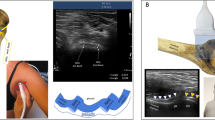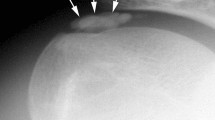Abstract
The purpose of this study was to investigate where the pain comes from in chronic mid-portion Achilles tendinosis, by using ultrasonography and colour Doppler, immunohistochemistry, and diagnostic injections. Twenty-five tendons in 24 patients (mean age 47 years) with the clinical diagnosis of painful chronic mid-portion Achilles tendinosis, and 20 tendons in 14 controls (mean age 48 years) with pain-free Achilles tendons were examined with ultrasonography and colour Doppler. For the 25 painful tendons, a local anaesthetic was injected in the area with neovascularisation outside the ventral part of the tendon. Biopsies taken from tendinosis tissue in six patients were used for PGP 9.5 immunohistochemistry. A neovascularisation, inside and outside the ventral part of the area with tendon changes, was demonstrated in all painful tendinosis tendons, but not in any of the pain-free control tendons. After injection of the local anaesthetic towards the neovessels outside the ventral part of the tendon, the pain during tendon-loading activity was temporarily cured in all patients. The mean VAS-score for heel-raises decreased significantly from 75 mm to 6 mm. In biopsies, PGP 9.5 immunohistochemistry showed nerve structures in the vicinity of blood vessels. In conclusion, we demonstrate findings which support neovessels and accompanying nerves being the possible source of pain in chronic mid-portion Achilles tendinosis.



Similar content being viewed by others
References
Alfredson H, Thorsen K, Lorentzon R (1999) In situ microdialysis in tendon tissue: high levels of glutamate, but not prostaglandin E2 in chronic Achilles tendon pain. Knee Surg Sports Traumatol Arthrosc 7:378–381
Alfredson H, Lorentzon R (2000) Chronic Achilles tendinosis. Recommendations for treatment and prevention. Sports Med 29:135–146
Alfredson H, Ljung BO, Thorsen K, Lorentzon R (2000) In vivo investigation of ECRB tendons with microdialysis technique: no signs of inflammation but high amounts of glutamate in tennis elbow. Acta Orthop Scand 71:475–479
Alfredson H, Forsgren S, Thorsen K, Fahlström M, Johansson H, Lorentzon R (2001) Glutamate NMDAR1 receptors localised to nerves in human Achilles tendons. Implications for treatment? Knee Surg Sports Traumatol Arthrosc 9:123–126
Alfredson H, Forsgren S, Thorsen K, Lorentzon R (2001) In vivo microdialysis and immunohistochemical analyses of tendon tissue demonstrated high amounts of free glutamate and glutamate NMDAR1 receptors, but no signs of inflammation, in jumper's knee. J Orthop Res 19:881–886
Alfredson H, Bjur D, Thorsen K, Lorentzon R (2002) High intratendinous lactate levels in painful chronic Achilles tendinosis. An investigation using microdialysis technique. J Orthop Res 20:934–938
Åström M, Gentz CF, Nilsson P et al (1996) Imaging in chronic Achilles tendinopathy: a comparison of ultrasonography, magnetic resonance imaging and surgical findings in 27 histologically verified cases. Skeletal Radiol 25:615–620
Åström M (1997) On the nature and etiology of chronic Achilles tendinopathy. Dissertation, University of Lund, Lund, Sweden
Dickenson AH, Chapman V, Green GM (1997) The pharmacology of excitatory and inhibitory amino acid-mediated events in the transmission and modulation of pain in the spinal cord. A review. Gen Pharmacol 28:633–638
Dubowitz V (1985) Muscle biopsy. A practical approach. Baillière Tindall, London, pp 29–34
Fava RA, Olsen NJ, Spencer-Green G, Yeo K-T, Yeo T-K, Berse B, Jackman RW, Senger DR, Dvorak HF, Brown LF (1994) Vascular permeability factor/endothelial growth factor (VPF/VEGF): accumulation and expression in human synovial fluids and rheumatoid synovial tissue. J Exp Med 180:341–346
Ferrara N (1999) Molecular and biological properties of vascular endothelial growth factor. J Mol Med 77:527–543
Hansson M, Forsgren S (1995) Immunoreactive atrial and brain natriuretic peptides are co-localized in Purkinje fibres but not in the innervation of the bovine heart conduction system. Histochem J 27:222–230
Hobson MI, Brown R, Green CJ, Terengi G (1997) Inter-relationships between angiogenesis and nerve regeneration: histochemical study. Br J Plast Surg 50:125–131
Khan KM, Cook JL, Bonar F, Harcourt P, Åström M (1999) Histopathology of common tendinopathies. Update and implications for clinical management. Sports Med 27:393–408
Khan K, Cook JL, Maffulli N, Kannus P (2000) Where does the pain come from in tendinopathy? It may be biochemical, not only structural, in origin. Br J Sports Med 34:81–84
Kvist M (1994) Achilles tendon injuries in athletes. Sports Med 18:173–201
Maity P, Chakraborty S, Bhattacharya P (1999) Angiogenesis-a putative new approach in glutamine related therapy. Pathol Oncol Res 5:309–314
Movin T (1998) Aspects of aetiology, pathoanatomy and diagnostic methods in chronic mid-portion achillodynia. Dissertation, Karolinska Institute, Stockholm, Sweden
Movin T, Gad A, Reinholt FP (1997) Tendon pathology in long-standing achillodynia. Biopsy findings in 40 patients. Acta Orthop Scand 68:170–175
Öhberg L, Lorentzon R, Alfredson H (2001) Neovascularisation in Achilles tendons with painful tendinosis but not in normal tendons: an ultrasonographic investigation. Knee Surg Sports Traumatol Arthrosc 9:233–238
Öhberg L, Alfredson H (2002) Ultrasound guided sclerosing of neovessels in painful chronic Achilles tendinosis: pilot study of a new treatment. Br J Sports Med 36:173–177
Paavola M, Paakkala T, Kannus P et al (1998) Ultrasonography in the differential diagnosis of Achilles tendon injuries and related disorders. Acta Radiol 39:612–619
Pufe T, Petersen W, Tillman B, Mentlein R (2001) The angiogenic peptide vascular endothelial growth factor is expressed in foetal and ruptured tendons. Virchows Arch 439:579–585
Weinberg EP, Adams MJ, Hollenberg GM (1998) Color Doppler sonography of patellar tendinosis. Am J Roentgenol 171:743–744
Acknowledgement
Financial support has been received from the Swedish Council of Sports.
Author information
Authors and Affiliations
Corresponding author
Rights and permissions
About this article
Cite this article
Alfredson, H., Öhberg, L. & Forsgren, S. Is vasculo-neural ingrowth the cause of pain in chronic Achilles tendinosis?. Knee Surg Sports Traumatol Arthrosc 11, 334–338 (2003). https://doi.org/10.1007/s00167-003-0391-6
Received:
Accepted:
Published:
Issue Date:
DOI: https://doi.org/10.1007/s00167-003-0391-6




